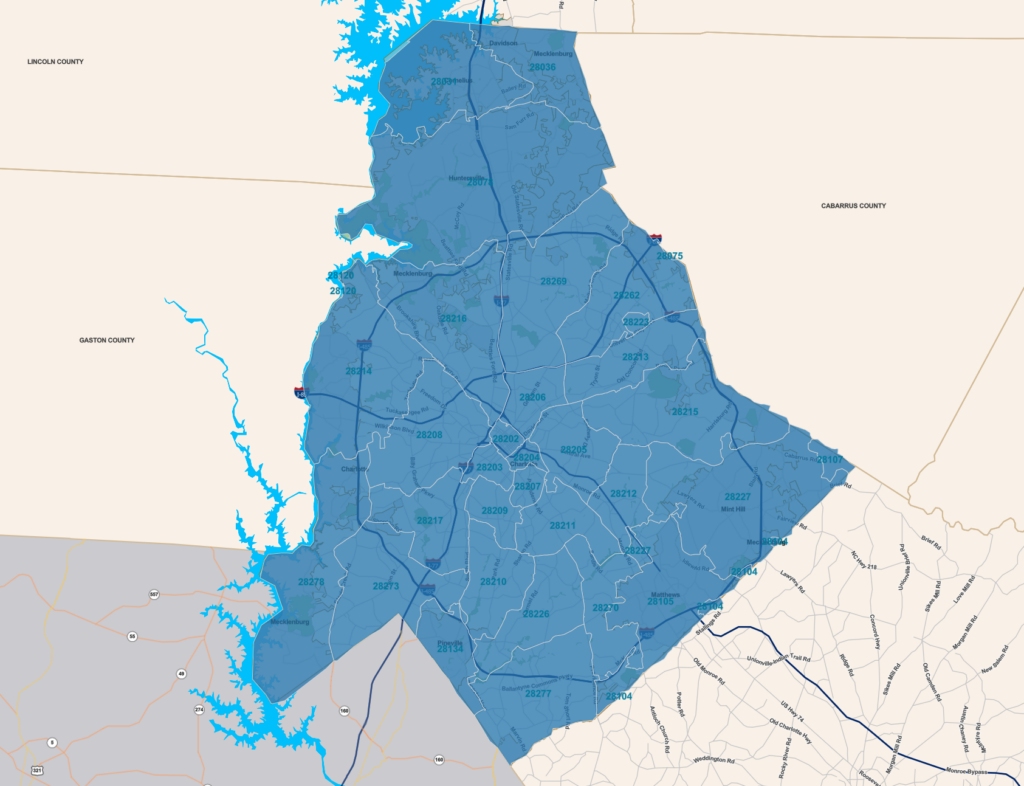How Much Should I Invest in Marketing?
When determining your advertising budget, it’s crucial to consider essential factors such as your business goals, target geographic area, and the products or services you wish to promote. These elements play a significant role in shaping your marketing strategy and ensuring your campaigns are tailored to your unique business needs.
Budget Calculator
Average Daily Budget Allocation Per Zip Code
Charlotte:
Mecklenburg County:
North Carolina:
10 Zip Codes Focus:
Striking the Perfect Balance
The truth is, there isn’t a one-size-fits-all advertising budget. Each business is unique, with its own set of requirements and objectives. Individual business goals should guide your decision-making process when allocating resources for advertising. The good news is that budgets can be adjusted at any time to meet changing needs and priorities.
Making Informed Decisions
A popular strategy for determining your marketing budget involves projecting sales for the next 12 months and allocating a certain percentage of that figure to your advertising efforts. We’ve found that clients who plan ahead and adopt a long-term perspective tend to achieve better results. By carefully evaluating your expected revenue, you can make well-informed decisions about your marketing budget and ensure that it aligns with your overall business objectives.
Reality Check
Suppose your annual budget is set at $12,000. This figure may be substantial or insufficient, depending on various factors. To assess its adequacy, we’ll examine it at face value. Our calculator indicates that a $12,000 annual budget translates to a daily spend of $32.88. Rather than asking if $32.88 is enough, you should be asking, “Is $32.88 sufficient to advertise my business in Charlotte, NC?” or “Is $32.88 adequate to promote three services in Charlotte, NC?” Delving deeper into these questions can provide valuable insights.
Focus on Key Services & Products
When deciding which products and services to advertise, prioritize the most profitable ones. It’s also crucial to remember that the more products and services you promote, the smaller the share of your total budget each will receive. For instance, if you advertise 10 services, each will only get $3.29, which might not be sufficient. Instead, we recommend concentrating on a smaller number of offerings to ensure that each receives a more substantial budget allocation.

Geographic Targeting: Quality Over Quantity
The geographic area you target in your advertising campaign is just as important as the products and services you promote. A larger area means fewer dollars are spent per square mile, which can make your ads less competitive. To put things into perspective, consider the following:
- 39 zip codes in Charlotte, NC
- 64 in Mecklenburg County
- 802 in North Carolina
With a $12,000 annual budget, targeting all of Charlotte, NC, would result in an average of $0.84 spent per zip code, which is unlikely to yield competitive results. It’s clear that targeting all of Charlotte, Mecklenburg County, or the entire state of North Carolina with this budget would not be feasible. Instead, we recommend focusing on a select few zip codes or specific areas within Charlotte, allowing for a more concentrated spend in the locations where your target audience resides. This approach can lead to a much better return on investment.
A few helpful data points for context:
Harnessing Competitive Metrics for Market Share Insights
Competitive metrics, such as search impression share, are invaluable for understanding how your advertising performance compares to that of your competitors. Search impression share reflects the percentage of impressions your ads receive relative to the total number of impressions they could potentially obtain. By monitoring and analyzing search impression share, we can pinpoint areas where your ads may be underperforming or identify opportunities for improvement. This information enables us to make data-driven decisions about optimizing your campaigns, adjusting your bids, and refining your targeting strategies, ultimately enhancing your overall visibility and driving better results for your business.
A Holistic Approach to Budgeting
When establishing the ideal advertising budget for your digital marketing campaigns, it’s essential to consider factors such as daily spend, target geographic area, and the number of services promoted. While it might be tempting to cover a larger area or promote a wide range of products and services, doing so could spread your resources too thin and lead to diminishing returns. A less focused approach can make it challenging for your ads to stand out in a competitive landscape. Instead, it’s best to concentrate on a select few services or products that genuinely embody your brand’s value proposition.
This targeted approach not only helps you maximize your return on investment but also ensures that your advertising dollars work harder and smarter for your business. By carefully evaluating your daily spend, target geographic area, and the number of services you promote, you can create a tailored advertising strategy that aligns with your unique business goals.
Crafting an effective advertising budget requires a thoughtful approach that considers multiple factors, including your specific business objectives, the products or services you wish to promote, and the geographic areas you want to target. By striking the right balance between these elements, you can optimize your ad spend and achieve the best possible return on investment.
Remember that flexibility is key when it comes to advertising budgets. As your business evolves and your goals shift, don’t hesitate to reassess and adjust your budget accordingly. By staying adaptable and making data-driven decisions, you’ll be well-equipped to navigate the ever-changing landscape of digital marketing and set your business up for lasting success.









